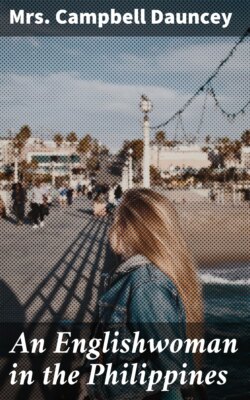Читать книгу An Englishwoman in the Philippines - Mrs. Campbell Dauncey - Страница 6
На сайте Литреса книга снята с продажи.
LETTER II.
FROM MANILA TO ILOILO
ОглавлениеTable of Contents
S.S. “Kai-Fong,” China Sea, December 1, 1904.
I hear there will be a mail going out from Iloilo to-morrow, the day we arrive, so I will write you a letter to go by it, that you may not be disappointed—six weeks hence!
We left Manila at three o’clock on Monday, in lovely sunshine, and had a delightful voyage through scenery which was simply a miracle of beauty. The sky was intensely blue, with little white clouds; the sea calm and still more intensely blue, dotted with dreams of islands, some mauve and dim and far away, some nearer and more solid-looking, and a few quite close, so that we could see the great forests of bright green trees and the grassy lawns, which cover the hills and clothe the whole islands down to long, white, sandy beaches, with fringes of palm trees.
The islands are volcanic, mountainous, and of all shapes and sizes, from Luzon, which is nearly the size of England,[1] and Mindanao, which is larger still, down to tiny fantastic islets, but all rich, green, fertile—even a rock poking its head out of the brilliant sea, has its crown of green vegetation. I don’t know at what size an island ceases to be an island and becomes a mere rock, but anyhow, there are two thousand Philippines considered worth enumerating.
I noticed very few signs of cultivation, or even of human habitation, but was told that even if there were villages in sight, they would be difficult to distinguish, unless we passed close to them, as they are built of brown thatch, and placed amongst the trees. Here and there was a little group of white buildings, generally, in fact always, clustering round a huge church. We passed quite close to some of the islands, so that we saw the trees and beaches clearly, but even those at a distance were very distinct, and I was particularly struck with the absence of colour-perspective, for the islands some way off, if they were not so far away as to look mauve, were just as brilliantly green as those close at hand. One after another, like a ceaseless kaleidoscope, these fairy islands slipped past all day—in fact, as I write, I can hardly keep my attention on my letter, the scenery is so wonderful and so constantly varying.
We got to Cebú, which is the chief town of the island of that name, at six o’clock on Wednesday morning, and anchored just off the town, which appeared as a flat jumble of grey corrugated iron roofs and green trees, rather shut in by high mountains close behind. On account of these hills, they say Cebú is much hotter than Iloilo, as the latter town lies open to the Monsoons.
These are the chief towns of the Philippines: Manila, the capital, in Luzon; Iloilo, in Panay; and Cebú, in Cebú; and that is the order they come in as to size, though between the two provincial towns there is endless rivalry on the subject of importance. In fact they are a sort of local Liverpool and Manchester—bitterly jealous, and yet pretending to despise each other. There was a P. and O. cargo steamer anchored not far from us, the first ever seen at Cebú, and everyone seemed very proud of the event.
When we went on deck, we saw a couple of canoes, hollowed out of big tree trunks, circling round, and containing natives dressed in loin-cloths, offering to dive for coins, in the approved fashion, west of Port Saïd. They were fine young men, yellowy brown in colour, and they made a great deal of noise, but did not dive very well. After breakfast some of C——‘s friends came off in a launch and took us ashore, when we drove in the usual little victoria, drawn by two small ponies, to the British Vice-Consulate, a large house on the borders of the town, where the Vice-Consul, Mr. Fulcher, entertained us royally.
Here I followed the same programme as I did at Manila, resting in the cool house all the long, hot day, and driving out in the evening at about five o’clock, when the sun had begun to go down. We drove all through dim streets, with a gorgeous sunset fading in the sky, and I could not make things out very distinctly, but could see that we were passing along ramshackle, half-country roads with overshadowing trees, and every now and then we passed a row of little open shops with bright lights in them, and natives squatting about. There are no bazaars in this country, by-the-bye, only little mat-shed shops where food is sold.
That was all I saw of Cebú, as I did not go out this morning, and we sailed in the afternoon. When we came down to the wharf to get on board, the tide, or the Port Doctor, had allowed of the Kai-Fong, drawing up to the wharf, so we came on board up a plank, when one had to look at the ship instead of the water on each side! The ship was very busy getting a cargo of hemp into one of the holds, hemp being the peculiar produce of the Island of Cebú and the opposite ones of Samar and Leyte, all long-shaped islands lying almost parallel in the middle of the Archipelago.
